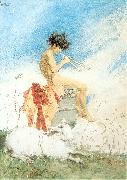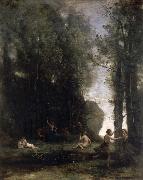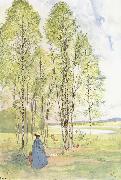
Oil On
Canvas, Real Flavor of Old Masters
|
Marsal, Mariano Fortuny y
|
|||
|
|
|||
| Spanish, 1838-1874 Painter and etcher. His work drew both on earlier Spanish art, especially the paintings and etchings of Goya, and on contemporary foreign works, notably the paintings of the Italian Macchiaioli and those of the French artist Ernest Meissonier. | |||
|
|
|||
|
|
Idyll new5/Marsal, Mariano Fortuny y_ZfjCbd.jpg Painting ID:: 19309 Visit European Gallery |
1868 Watercolor on paper Museo del Prado, Madrid. | |
Height Width |
INS/CM |
||
|
X |
|
||
|
|
|||
|
camille corot
|
|||
|
|
|||
| Paris 1796-Paris 1875 Corot's students included Alfred Sisley, Camille Pissarro, Berthe Morisot, Stanislas Lepine, Adolphe Appian and Dagnan-Bouveret. French painter, draughtsman and printmaker. After a classical education at the Coll?ge de Rouen, where he did not distinguish himself, and an unsuccessful apprenticeship with two drapers, Corot was allowed to devote himself to painting at the age of 26. He was given some money that had been intended for his sister, who had died in 1821, and this, together with what we must assume was his family's continued generosity, freed him from financial worries and from having to sell his paintings to earn a living. Corot chose to follow a modified academic course of training. He did not enrol in the Ecole des Beaux-Arts but studied instead with Achille Etna Michallon and, after Michallon's death in 1822, with Jean-Victor Bertin. Both had been pupils of Pierre-Henri Valenciennes, and, although in later years Corot denied that he had learnt anything of value from his teachers | |||
|
|
|||
|
|
Idyll new12/camille corot-795344.jpg Painting ID:: 38738 Visit European Gallery |
mk141 1859 Oil on canvas 162.5x130cm | |
Height Width |
INS/CM |
||
|
X |
|
||
|
|
|||
|
Carl Larsson
|
|||
|
|
|||
| Swedish Realist Painter, 1853-1919 Swedish painter, illustrator and printmaker. He came from a poor family and studied (1866-76) at the Konstakademi in Stockholm, supporting himself throughout this period. From 1871 to 1878 he contributed illustrations to the comic journal Kaspar and the Ny illustrerad tidning. From 1875, for several decades, he was a prolific book illustrator, his most renowned work in this field being his drawings for Föltskärns beröttelser ('The Barber-surgeon's tales'; pubd 1883-4) by Zacharius Topelius, and the Rococo-inspired watercolours for the Samlade skaldeförsök ('Collected attempts at poetry'; pubd 1884) by the 18th-century Swedish author Anna Maria Lenngren. | |||
|
|
|||
|
|
Idyll new16/Carl Larsson-295899.jpg Painting ID:: 41676 Visit European Gallery |
mk163 Watercolor 1901 | |
Height Width |
INS/CM |
||
|
X |
|
||
|
|
|||
|
Piet Mondrian
|
|||
|
|
|||
| Dutch 1872-1944 Piet Mondrian Location was a Dutch painter. He was an important contributor to the De Stijl art movement and group, which was founded by Theo van Doesburg. He evolved a non-representational form which he termed Neo-Plasticism. This consisted of a grid of vertical and horizontal black lines and the use of the three primary colours. When 47-year-old Piet Mondrian left his artistically conservative native Holland for unfettered Paris for the second and last time in 1919, he set about at once to make his studio a nurturing environment for paintings he had in mind that would increasingly express the principles of Neo-Plasticism about which he had been writing for two years. To hide the studio's structural flaws quickly and inexpensively, he tacked up large rectangular placards, each in a single color or neutral hue. Smaller colored paper squares and rectangles, composed together, accented the walls. Then came an intense period of painting. Then again he addressed the walls, repositioning the colored cutouts, adding to their number, altering the dynamics of color and space, producing new tensions and equilibrium. Before long, he had established a creative schedule in which a period of painting took turns with a period of experimentally regrouping the smaller papers on the walls, a process that directly fed the next period of painting. It was a pattern he followed for the rest of his life, through wartime moves from Paris to London??s Hampstead in 1938 and 1940, across the Atlantic to Manhattan. At 71 in the fall of 1943, Mondrian moved into his second and final New York studio at 15 East 59th Street, and set about again to create the environment he had learned over the years was most congenial to his modest way of life and most stimulating to his art. He painted the high walls the same off-white he used on his easel and on the seats, tables and storage cases he designed and fashioned meticulously from discarded orange and apple-crates. He glossed the top of a white metal stool in the same brilliant primary red he applied to the cardboard sheath he made for the radio-phonograph that spilled forth his beloved jazz from well-traveled records, Visitors to this last studio seldom saw more than one or two new canvases, but found, often to their astonishment, that eight large compositions of colored bits of paper he had tacked and re-tacked to the walls in ever-changing relationships constituted together an environment that, paradoxically and simultaneously, was both kinetic and serene, stimulating and restful. It was the best space, Mondrian said, that he had ever inhabited. Tragically, he was there for only a few months: he died of pneumonia in February 1944. | |||
|
|
|||
| This artist (Piet Mondrian) is not available now. | |||
|
|
|||









